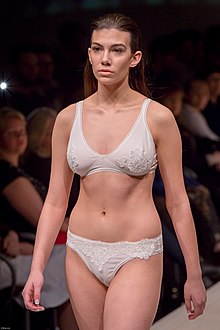
Lingerie (UK: ⫽ˈlæ̃ʒəri, ˈlɒn-⫽, US: ⫽ˌlɒnʒəˈreɪ, ˌlænʒəˈriː⫽,[1] French: [lɛ̃ʒʁi] ) is a category of primarily women's clothing including undergarments (mainly brassieres), sleepwear, and lightweight robes. The choice of the word is often motivated by an intention to imply that the garments are alluring, fashionable, or both.[citation needed] In a 2015 US survey, 75% of women reported having worn "sexy lingerie" in their lifetime.[2]
Lingerie is made of lightweight, stretchy, smooth, sheer or decorative fabrics such as silk, satin, Lycra, charmeuse, chiffon, or (especially and traditionally) lace. These fabrics can be made of various natural fibres like silk, cotton or of various synthetic fibres such as polyester or nylon.

The word lingerie is a word taken directly from the French language, meaning undergarments, and used exclusively for more lightweight items of female undergarments.[3] The French word in its original form derives from the French word linge, meaning 'linen' or 'clothes'. [4] Informal usage suggests visually appealing or even erotic clothing. Although most lingerie is designed to be worn by women, some manufacturers now design lingerie for men.
The concept of lingerie as a visually appealing undergarment was developed during the late nineteenth century. Lady Duff-Gordon of Lucile was a pioneer in developing lingerie that freed women from more restrictive corsets. Through the first half of the 20th century, women wore underwear for three primary reasons: to alter their outward shape (first with corsets and later with girdles or brassieres), for hygienic reasons and for modesty. Before the invention of crinoline, women's underwear was often very large and bulky.
During the late 19th century, corsets became smaller, less bulky and more constricting and were gradually supplanted by the brassiere, first patented in the 20th century by Caresse Crosby. When the First World War broke out, women found themselves filling in men's work roles, creating a demand for more practical undergarments. Manufacturers began to use lighter and more breathable fabrics. In 1935, brassières were updated with padded cups to flatter small breasts and three years later underwire bras were introduced that gave a protruding bustline. There was also a return to a small waist achieved with girdles. The 1940s woman was thin, but had curvaceous hips and breasts that were pointy and shapely. In the 1960s, the female silhouette was liberated along with social mores. The look was adolescent breasts, slim hips, and extreme thinness. André Courrèges was the first to make a fashion statement out of the youth culture when his 1965 collection presented androgynous figures and the image of a modern woman comfortable with her own body.[5]
As the 20th century progressed, underwear became smaller and more form fitting. In the 1960s, lingerie manufacturers such as Frederick's of Hollywood begin to glamorise lingerie. The lingerie industry expanded in the 21st century with designs that doubled as outerwear. The French refer to this as 'dessous-dessus,' meaning something akin to innerwear as outerwear.[6]

The global lingerie market in 2003 was estimated at $29 billion, while in 2005, bras accounted for 56 per cent of the lingerie market and briefs represented 29 per cent. The United States's largest lingerie retailer, Victoria's Secret,[7] operates almost exclusively in North America, but the European market is fragmented, with Triumph International and DB Apparel predominant.[8] Also prominent are French lingerie houses, including Chantelle and Aubade.
In March 2020 The Guardian reported a trend for male lingerie on the catwalk and predictions as to the likelihood of it successfully extending to the high street fashion stores.[9]
|
See also: Sumptuary law |
The Iranian regime regularly bans vendors who procure and sell imported lingerie dresses.[10]
